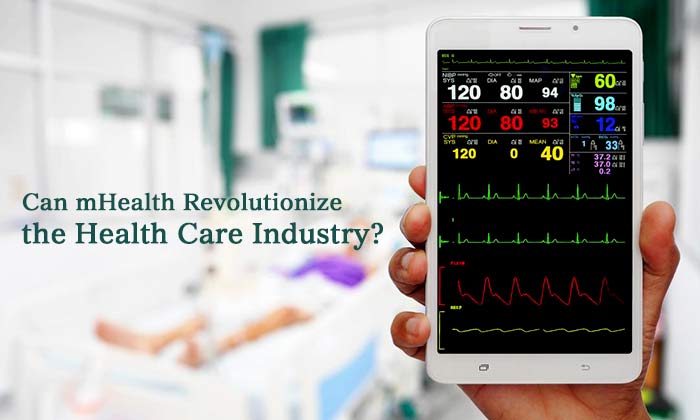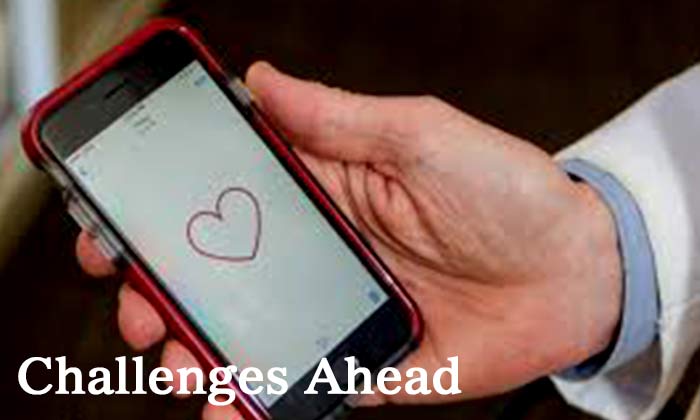
Can mHealth Revolutionize the Healthcare Industry?

Health care professionals as well as patients are skeptical about electronic health (mHealth). Doctors do not have sufficient time and patients may be bothered about the data going wrong. The usage of Mobile Health is less prominent. So, in this regard, we try to analyze its pros and cons.
Given the extent of advancement in technology in the last few years, it is not astonishing that around 4.68 billion people will become users of mobile phones by 2019. In the U.S., 40% of the physicians work on weekends and in the evenings. This can isolate patients, who work 9-5.
In developing African countries like Zimbabwe the condition is really bad. There is only one doctor per 10,000 people. And, statistics are no different for other developing countries. As per the ICT Household Survey by National Statistics Agency in Zimbabwe, on a national level, about 89% of the households have at least one member, who uses a cell phone [1] . So, it is instinctual to exploit cell phones and other electronic devices to make healthcare more convenient to everyone.
According to West Wireless Health, the spread of cell phones all around even in places, where basic healthcare infrastructure is missing, has been contributing to the development of mHealth. But, despite the advent of electronic heath (eHealth) and Mobile Health (mHealth), many people are still not sure of its benefits and usage.
What is mHealth?

As a matter of fact, there is no standard definition of mHealth. However, for the requirement of a survey conducted by Global Observatory in 2009, mHealth was defined as “medical health practice supported by mobile and similar devices like cell phones, personal digital assistants (PDA), patient monitoring devices and other wireless equipment.
With about 4.7 billion users of cell phone across the globe, usage of these devices can be a great step towards attaining global wellness[2]. mhealth alliance says that the commonness in usage of the mobile devices in both developed and developing countries gives an opportunity to improve health outcomes via the delivery of innovative medical and health services through information and communication technologies reaching the farthest points on the globe.
Since the time of their introduced in the 20th century, these devices have helped improve connectedness and probably, the most important benefit is that it helps us remain connected to our heath care provider from all distances and at all times. So, we can immediately get the doctor’s advice on whatever health condition we have, including diabetes, hypertension and more.
How Does mHealth Help Us?
Mhealth has the potential to improve our connectivity and subsequently, the ease of care and quality of life when used in the right manner. There are many benefits like improvement in adherence to medication and getting aggregated patient data.
Compliance to Treatment
A great challenge is to make sure that patients take the right medicine when they are supposed to. Authors of a study, issued in Risk Management and Health Care Policy, wrote that non adherence to medication is a widespread issue and varies according to the disease, characteristics of the patients and insurance coverage. The rates of non-adherence range from 25-50%. Not taking the right medicines results in poor therapeutic outcomes, advancement of the disease and unnecessary surge in direct healthcare costs.
There are many issues related to non-compliance with medicines like hospitalization, poor quality of life, relapse, flare up of the diseases and even mortality. There are some mHealth apps [3] that can be easily downloaded on the smartphone that can help people with their treatment regime and schedule as it aids in tracking pills whether the pills have been taken or not taken on the prescribed time.
Improvement in Monitoring

These mHealth apps can connect patients to their respective health care providers; thus, allowing them to chat with their doctors at any given point in time and take his advice on the condition, drug and symptoms for better outcomes. So with this, early intervention is possible without delay.
If a patient is suffering from some condition and cannot connect with a doctor physically, mHealth apps can be a savior. hence, patient’s life can be saved. Some of the mHealth apps can also store the patient’s data and general health care data at a single place. Therefore, the doctor can use the most advanced form of treatment to ensure that the patient gets the best possible healthcare support. This further enables health care professionals to remain acquainted with the recent practices; thereby, giving them a better idea of how to proceed with the patient’s care.
Paperless Information
The increase in the popularity of various devices like laptops, tablets, cell phones and PDA is great for the environment. In fact, today there is hardly any documentation and paper-based communication.
Going paperless eliminates hospital and office supply costs and decreases wastage. The clutter in the office of the doctor also decreases and the patients’ data can be stored in a safer place.
Cons of mHealth
For a long time now, we have been resisting any advances in technologies that may take the power away from us. In a lot of ways, this is what mHealth apps do. They take away the responsibility from the hands of the health care professionals and give it away to the cyberspace. And, this could do you more harm than good.
Lack of Regulation
Before a drug starts selling in the market, it must go through the U.S. FDA for approval of its safety. Without the agency’s approval, the drug can’t be sold. The FDA is responsible for ensuring the efficacy, safety and security of medical drugs. In 2017, there were around 325,000 mHealth apps available. However, the FDA has approved only some.
Mhealth apps are not on the priority list of the FDA as they are non-invasive and less likely to cause any physical harm. So, they may not require regulations as other drugs and therapies.
Hence, the app development companies can get started with them faster and also there is less testing with regards to any app-related issue, which may display problems in future. The app development companies may easily get the approval.
People Rely on Them Blindly
As discussed above, while so many of the mHealth apps are not tested or approved by regulatory agencies like the FDA, people are too reliant on them in everyday lives. Many people use them instead of going for professional help. It is important to understand that not all such apps are regulated.
In 2015, a study was conducted on the symptom checking apps and websites. It was found by the researchers that from the top 23 symptom checkers, correct diagnoses was made in only 34% of standard patient evaluations. It was also found that the correct diagnosis was listed in the top 20 possible diagnoses in less than 60% of the cases. The implications of these are dangerous since getting the wrong diagnosis could affect the treatment and can be dangerous too.
Future of mHealth
It is believed that the future of health care is mHealth, but what is the future of mHealth? We need to know where this technology is taking us and the health care industry on the whole.
Wearables are a part of so many people’s life and it has never been easier to see a doctor. So, mHealth is there to offer easy access to healthcare while reducing the cost of the same. These mHealth apps can help track symptoms and assist you in remaining connected to your health care service providers.
Besides, this decreases the need of invasive treatments. The goal of mHealth developers is openness. James Michiel, an mHealth and informatics analyst, asserts that mHealth’s future is open – open access, open data, open source and open innovation. However, there are still many hindrances to achieving this goal.
Challenges Ahead

For the growth of mHealth, proper regulation is crucial. Researchers say that eHealth has the potential to surpass the sociopolitical boundaries and this will help have a borderless world for easy health delivery. Policy for guiding eHealth is limited and only recently coming up in the developed world.
To foster the growth of eHealth in the developing countries, policies should be introduced that facilitate mobility of the patients and data exchange across regional boundaries and international borders.
What’s Next?
Harold Thimbleby, computer science professor at Swansea University, says that the future of health care is about taking care of the patients, but the patients are not the primary stakeholders. There are many other stakeholders in the healthcare sector. Doctors, suppliers, insurance companies, managers, big pharma, governments, builders and many other forces will influence the future of mhealth.
Questions like whether innovation can be helpful for the patients or would it be for monitoring clinicians that offer health care service are crucial to the development of mHealth. Rightly developed means of delivering treatment can alleviate risk to patients and fit in best practices for doctors.
But, whatever comes up next, Michiel says that there has never been a history of so many powerful platforms and tools available to those, who have been marginalized from innovation and technology. However, he adds, it is all-important that these technologies should be used efficiently and deliberately, keeping in mind that they must remain sustainable in the long run.




